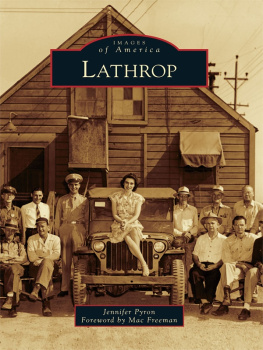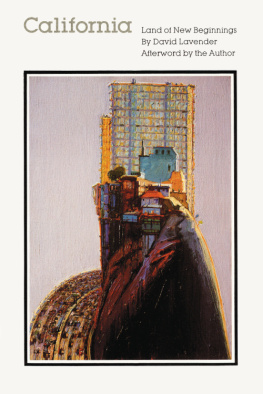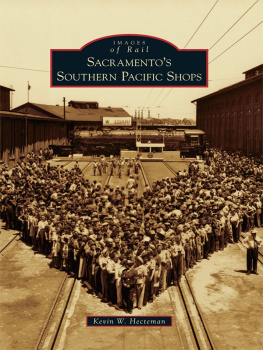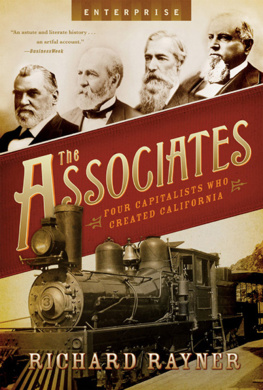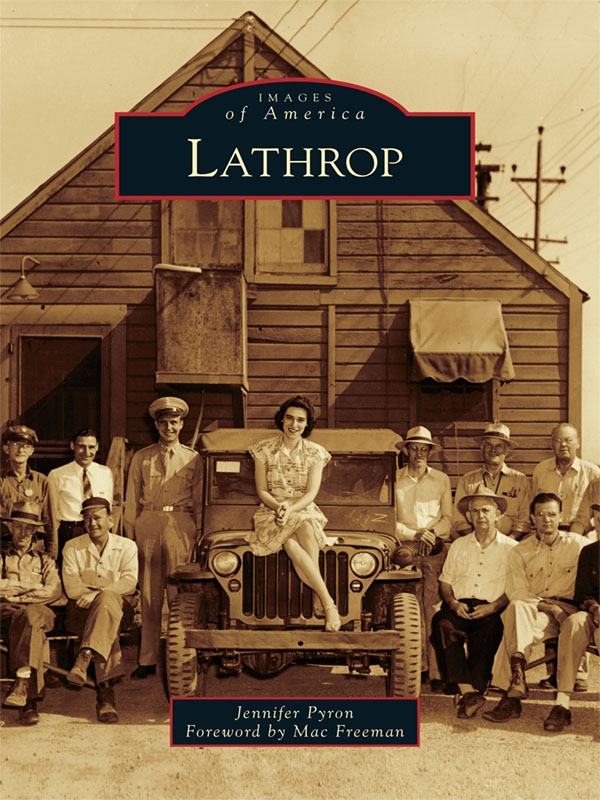I would like to thank everyone who so graciously contributed to this project. For their time and assistance in the research and putting together of this book, I would like to extend my appreciation to Arcadia Publishing and John Poultney, my editor, for patiently helping me through the process. My thanks go to the following residents of Lathrop, professionals, and institutions for granting me access to their collections of photographs and information and offering their knowledge of Lathrop to assist me in this work, especially Mac Freeman; Roy Tinnin; Susan DellOsso; Lathrop mayor Kristy Sayles; David Silveria; Diane Hirata; Margaret Luevano; Arnita Montiel; Bennie and Joyce Gatto; Ralph Lea of Lodi; Gary Kinst, Larry Mullaly, and Kevin Hecteman for their railroad expertise; Cara Randall and the California State Railroad Museum; Bill Maxwell and the Bank of Stockton Archives; Leigh Johnsen and the San Joaquin County Historical Museum; Debbie Cismowski at the Caltrans Library in Sacramento; the Manteca Unified School District; the Bancroft Library at the University of California, Berkeley; Mike Wurtz and the University of the Pacific archives; Stacy Mueller and the California Room at the San Jose Public Library; and many others not named here.
Finally, this book would not have been possible without the support of my family and friends, especially my husband, Justin Pyron. Thank you for your love, patience, and confidence in me while I researched and wrote this book. My sincere gratitude goes to my mother, Peggy Maurer, for her encouragement, for assistance in editing, and for babysitting my young children so I could go research. Last but certainly not least, I must thank my children, Amber and Tristan Pyron, who patiently accompanied me on various excursions in the researching and assembling of this book. I hope when you are grown you remember where you grew up and are proud to share its history.
APPENDIX A
TIMELINE
BEFORE 1832 OR 1833: Area is inhabited by the Yokut Native American tribe.
18281845: Trappers, hunters, and fishermen are in the Mossdale area of Lathrop.
1844: William Gulnac acquires this part of the valley as a grant from the Mexican government.
1845: Gulnac sells to Capt. Charles M. Weber the area just west of present-day Lathrop (called Weber Grant).
1849: John Doak and Jacob Bonsell establish the first ferry on the San Joaquin River at Mossdale.
1853: John Morrison buys 2,560 acres of land from Weber. The area is known as Wilsons Station.
1856: Doak and Bonsell sell ferry to William Moss.
1869: Leland Stanford changes the town name to Lathrop. On November 10, San Joaquin River bridge is completed, and the Transcontinental Railroad is completed.
1870: On May 22, the first train through from East Coast to San Francisco crosses the bridge.
1886: Fire burns most of Seventh Street, some of Sixth Street, the railroad depot, and the terminal.
1889: Former California Supreme Court justice David S. Terry is shot by U.S. Marshal David Neagle.
1891: The Southern Pacific Railroad constructs a new depot.
1942: The Sharpe depot is officially dedicated as Lathrop Holding and Reconsignment Point.
1948: The army depot is renamed Sharpe General Depot.
1970s: In the early 1970s, the Southern Pacific Railroad depot is removed.
1989: Lathrop is incorporated.
1990s: The Union Pacific Railroad builds an intermodal facility near the Sharpe depot.
2005: The new Lathrop City Hall is built.
APPENDIX B
BENJAMIN HARRISONS SPEECH
On April 25, 1891, Pres. Benjamin Harrison stopped in Lathrop while on a train tour around the country. Included here is a description of his visit and the speech he gave while at Lathrop from Speeches of Benjamin Harrison, Twenty-third President of the United States , compiled by Charles Hedges and published by the New York United States Book Company in 1892.
The presidents arrival at Lathrop was celebrated by several thousand residents, reenforced by large delegations from the neighboring city of Stockton. The Committee of Reception consisted of James J. Sloan, A. Henry Stevens, Z. T. White, O. H. P. Bailey, E. Jesurun, T. B. Walker, W. S. Reyner, D. Sanguinite, Geo. H. Seay, O. D. Wilson, C. F. Sherburne, F. D. Simpson and F. J. Walker. The Committee of Reception appointed by the mayor of Stockton and participating on behalf of the city was J. K. Doak, F. J. Ryan, I. S. Haines and Willis Lynch, H. R. McNoble, J. M. Dormer, and F. T. Baldwin. A feature of the reception was 100 schoolchildren, each carrying a bouquet, which they presented to President and Mrs. Harrison, both of whom kissed several of the little donors. Postmaster Sloan delivered the welcoming address. The president, responded with the following speech:
My fellow citizensI should be less than human if I were not touched by the rapid succession of hearty greetings received by us in our journey through California. I should be more than human if I were able to say something new or interesting at each of these assemblies.
My heart has but one language: it is, I thank you.
Most tenderly do I feel as an individual so much of this kindness as is personal to me, and as a public official I am most profoundly grateful that the American people so unitedly show their love and devotion to the Constitution and the flag.
We have a Government of the majority; it is the original compact that when the majority has been fairly counted at the polls, the expressed will of that majority, taking the form of public law enacted by State Legislatures or the national Congress, shall be the sole rule of conduct of every loyal man. [cheers]
We have no other king than law and he is entitled to the allegiance of every heart and bowed kneed of every citizen. [cries of Good! Good! and cheers]
I cannot look forward with any human apprehension to any danger to our country, unless it approaches us through a corrupt ballot-box. [applause] Let us keep that spring pure and these happy valleys shall teem with an increasing population of happy citizens and our country shall find in an increasing population only increased unity and strength. [cheers]
Find more books like this at
www.imagesofamerica.com
Search for your hometown history, your old stomping grounds, and even your favorite sports team.
One
RAILROAD DAYS
Lathrops past is rich in railroad history. The Southern Pacific Railroad was formed in 1865 and was acquired in 1868 by the same financial interests that were creating the Central Pacific Railroad. Central Pacific completed its hotel and restaurant in Lathrop on May 10, 1871. By this time, Lathrop was a major railroad stop, as trains met here from the north, the south, the east, and San Francisco in the west. It also became an important shipping point for produce to the San Francisco Bay area. Lathrops railroad wye, tracks laid in a Y shape used to reverse the direction of a train, was said to be the biggest one west of the Mississippi River and the largest in California. Perhaps Lathrops biggest claim to fame in regards to the railroad is the trestle bridge built at Mossdale over the San Joaquin River. This bridge was the true last link in the Transcontinental Railroad. Construction of the tracks started simultaneously in the San Francisco Bay area and Sacramento and met here at the San Joaquin River. The first train ran on September 10, 1869, but for a couple months, folks traveled until Mossdale, unloaded their luggage, and crossed the San Joaquin River by ferryboat before boarding another train on the other side. This piece of the journey ended when the Southern Pacific Bridge, as it was known for many years, was formally opened on November 10, 1869, thus completing the Transcontinental Railroad. The railroad was the heart of Lathrop for a long while and built the town up in its early years.

